Designing with Care: An Interview with Diana Celella on Wellford Gardens Care Home
We are delighted to welcome Diana Celella, a renowned Interior Designer and the creative mind behind Drawing Room Interiors. With a wealth of experience and a specialization in healthcare design, Diana’s work is both innovative and impactful. Her recent project, Wellford Gardens care home, exemplifies her dedication to creating environments that promote residents’ dignity, independence, and confidence.
In this interview, we’ll uncover Diana’s career path, the unique strategies implemented at Wellford Gardens, the suppliers she collaborated with, and her perspectives on the future of healthcare design.

Diana Celella, Founder, Drawing Room Interiors
Could you start by introducing yourself and describing your role at The Drawing Room? What is your background in healthcare design?
I am Diana Celella, an Interior Designer who graduated from Teesside University in 1986. My journey in the design industry has been a long and fulfilling one, beginning with my initial role at Claude Hooper where I worked on pioneering retirement living projects. I later became the Design Manager for Hospitality at Harrop Design Consultants before establishing my own consultancy, Drawing Room Interiors, in 1989. My experience spans across various sectors including residential, hospitality, healthcare, education, and workplace design. As well as other prestigious awards, I was awarded West Midland Woman of the year 2016 for contribution to Education, which was referring to my work in evidence based design education.
Over the past 15 years, my focus has shifted predominantly to healthcare design, driven by my passion for evidence-based design. This approach emphasizes enhancing residents’ dignity, independence, and confidence through thoughtful and research-backed design solutions.
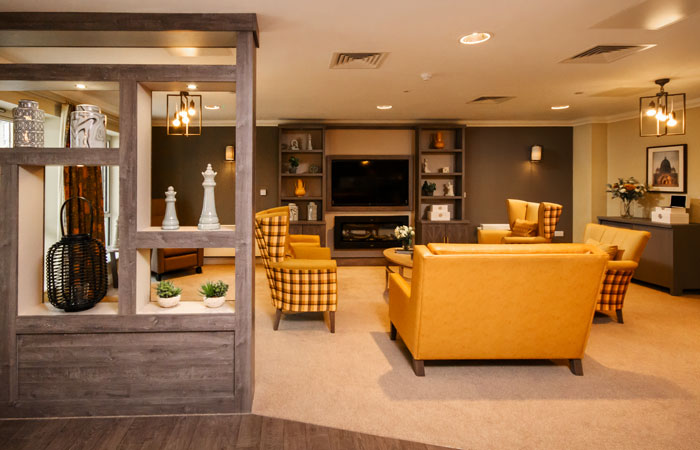
Order of St John Care Trust (OSJCT), Wellford Gardens
Tell us about your Wellford Gardens care project and how The Drawing Room come to be involved with this project?
This project is a new build care home located in the picturesque area of Wheatley, Oxfordshire, and operated by the Order of St John Care Trust (OSJCT). We tendered for the role of Interior Designer for this new build, as well as for refurbishments and creating a design manual for the trust. Our successful bid led to a rewarding collaboration with OSJCT, where we enjoyed bringing our vision to life and contributing to the creation of a comfortable and aesthetically pleasing environment for the residents.
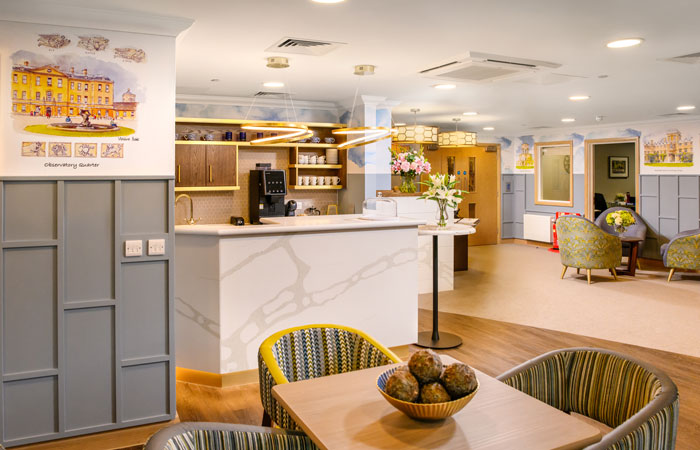
Order of St John Care Trust (OSJCT), Wellford Gardens, Reception
Building a good client relationship is crucial in healthcare projects. Can you discuss how you collaborated with the client throughout this project? What were some key inputs from the client that shaped the design process?
Building a strong client relationship is vital to ensure that the design aligns with their needs and expectations. Throughout this project, we held numerous meetings with the client to thoroughly understand the requirements of the end-users, the staff, and the operational aspects of the care home. One significant challenge was the main contractor, Castle Oak, going into receivership midway through the project. Despite this, we maintained clear communication and focused on delivering a high-end yet homely feel within budget constraints, as emphasized by the client. Incorporating local elements and themes was also a key directive, ensuring the design resonated with the community and the residents.
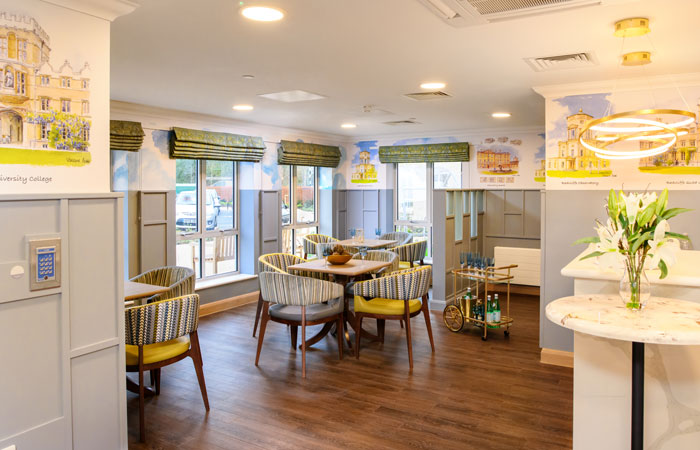
Order of St John Care Trust (OSJCT), Wellford Gardens, Bistro
What were the primary design considerations for this care facility? How did you balance aesthetics with the functional requirements of a care environment?
The primary design consideration was to create a space that is both aesthetically pleasing and highly functional for a care environment. My concept was rooted in the local culture and history of Oxfordshire. I collaborated with local artist Valerie Petts, whose architectural paintings were transformed into bespoke wallcoverings and murals, enhancing wayfinding and adding a personal touch. Working with a wallcovering designer and fabric manufacturers allowed us to create unique, cost-effective designs. These bespoke elements not only enhanced the visual appeal but also ensured practicality and durability, critical in a care setting.
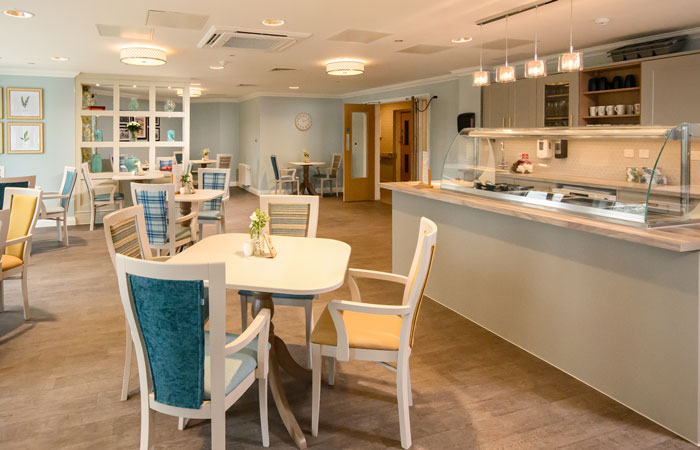
Order of St John Care Trust (OSJCT), Wellford Gardens, Dining Room
Care facilities require special attention to patient comfort and safety. Could you explain the user-centric design features that were integrated into this project to enhance patient care and experience?
Resident comfort and safety are paramount in our design approach. We carefully considered the ergonomics of furniture, ensuring it suited the needs of elderly individuals. Lighting design was another critical aspect, with levels adjusted to accommodate aging eyes, providing consistent illumination to ease transitions between spaces. Acoustic management was addressed to reduce noise levels and create a calm environment. Personalization was encouraged, particularly in private spaces like bedrooms, allowing residents to feel at home. Additionally, we provided solutions for residents with dementia, such as easily covered mirrors, to cater to their specific needs without compromising on comfort or aesthetics.
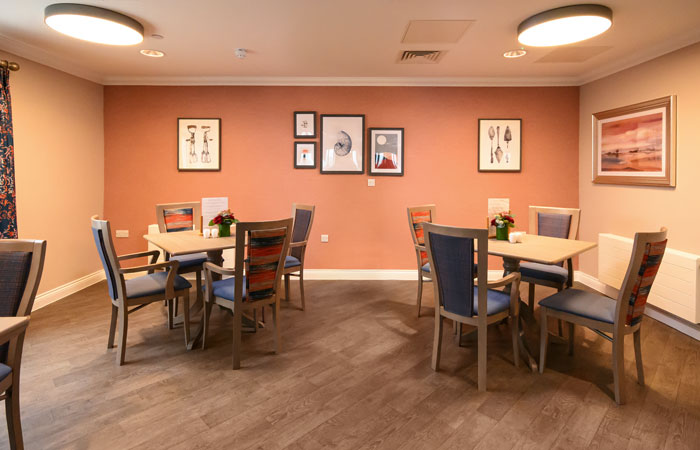
Order of St John Care Trust (OSJCT), Wellford Gardens, Dining Lounge
Could you give us a walkthrough of the project, highlighting three to five key spaces?
Reception/Bistro: This space serves as the front of house, welcoming visitors and residents. It features a bespoke mural using art by local artist Valerie Petts and panelled walls inspired by the local arts and crafts movement. Bespoke fabrics and furniture create a warm and inviting atmosphere. I used the remake software by Panaz to custom design many of the curtain and upholstery fabrics throughout the home.
Corridors: Each floor’s corridor features a unique lattice wallcovering design and large murals of local artwork. Themes such as literature, fashion, and science aid in wayfinding and add character to the space, but also connect to the location, using wayfinding such as George Orwell, inspired the writing corridor, Steven Hawkings inspired the astronomy corridor etc.
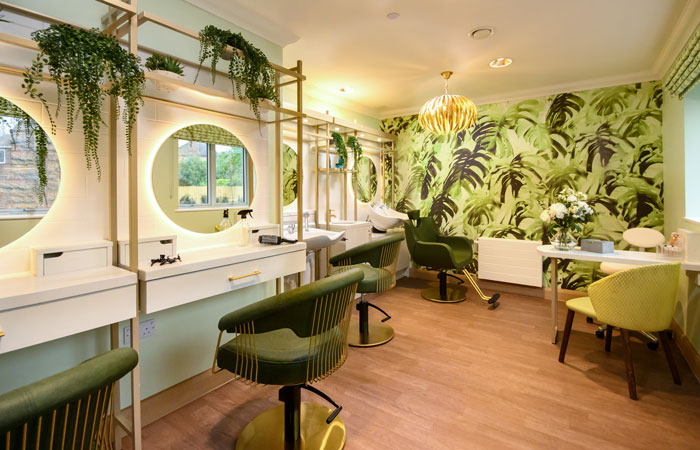
Order of St John Care Trust (OSJCT), Wellford Gardens, Hair Salon
Hair Salon: Designed to feel like a high-street salon, this biophilic space includes custom cabinetry and cheerful décor, providing a relaxing environment for residents. LRV has been looked at throughout to aid independence and confidence to the residence.
Private Dining Room: This intimate space is used for private gatherings and features bespoke fabrics and rich, inviting décor, with elements that support dementia-friendly design such as artwork which prompts the usage of the room.
Lounge/Dining Room (Ground Floor): This area is divided into smaller, more intimate zones using room dividers. Contrasting chair fabrics and tailored artwork enhance the dining experience and aid residents in navigating the space. Room dividers designed to ensure staff can still have full view of the room.
Additional Spaces: In addition to the primary care spaces, this project also included spaces such as a hair salon. What were the design objectives for these additional spaces, and how do they complement the overall aesthetics and functionality of the care facility?
The additional spaces, including a hair salon, library/cinema, private dining room, and activity room, were designed to enhance the lifestyle and community feel within the care home. These spaces aim to create a sense of normalcy and engagement for residents, encouraging social interaction and providing varied activities. Each space was designed to blend seamlessly with the overall aesthetics while meeting specific functional needs, thereby enhancing the overall quality of life for the residents.
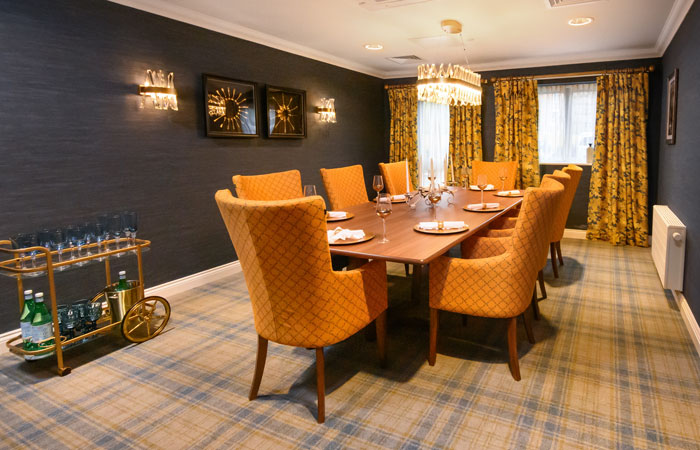
Order of St John Care Trust (OSJCT), Wellford Gardens, Private Dining
Selecting the right suppliers is essential for project success, especially in care settings. Who were the main suppliers for this project, and why were they chosen?
Juniper Partnership: Collaborated on FF&E, ensuring our designs were accurately interpreted and implemented.
Sylvan: Provided bespoke cabinetry, known for their quality, timely delivery, and excellent service.
Dynstry Wallcovering: Assisted with designing and supplying bespoke wallcoverings, with Mark Forest offering valuable expertise.
Teal and Shackletons: Supplied communal and bedroom furniture, respectively, chosen for their durability and comfort.
Edison and Day: Provided bedroom furniture, based on our drawings and design.
Furnish and Bridge: Supplied curtains for communal areas and bedrooms, enhancing the overall design.
Tektura: Provided wallcoverings, contributing to the unique and personalized interior environment.
Dan Flooring and Altro: Supplied flooring solutions, balancing functionality and design aesthetics.
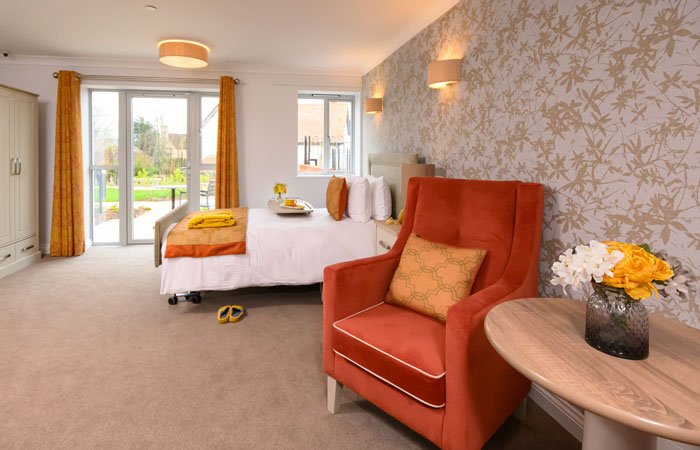
Order of St John Care Trust (OSJCT), Wellford Gardens, Bedroom
Every project comes with its own set of challenges. Could you share some specific challenges faced during this project and the solutions that were implemented?
One of the major challenges was the main contractor, Castle Oak, going into receivership, which caused significant delays. Additionally, the project was affected by the impacts of COVID-19 and Brexit, leading to increased costs and supply chain issues. To address these challenges, we implemented value engineering strategies to manage costs without compromising the design quality. Effective communication and flexibility were crucial in navigating these obstacles, ensuring that we could still deliver a high-quality care environment.
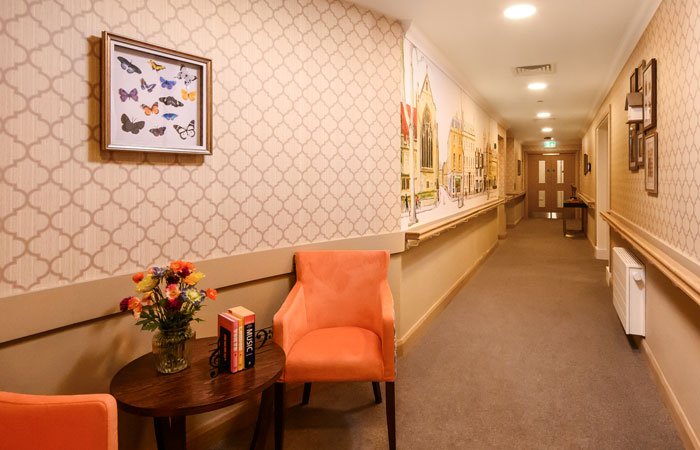
Order of St John Care Trust (OSJCT), Wellford Gardens, Corridor
As care design continues to evolve, what future trends or innovations are you most excited to incorporate into upcoming projects at The Drawing Room?
The future of care design is exciting, with new evidence-based approaches continually emerging. We are increasingly considering the needs of an aging workforce within care homes, alongside those of the residents. Innovations in technology, such as virtual reality, offer new ways to design and improve independence for residents. Additionally, advances in materials and design techniques allow us to create more personalized and effective care environments. We are committed to staying at the forefront of these trends, integrating them into our projects to enhance the well-being and quality of life for all users.
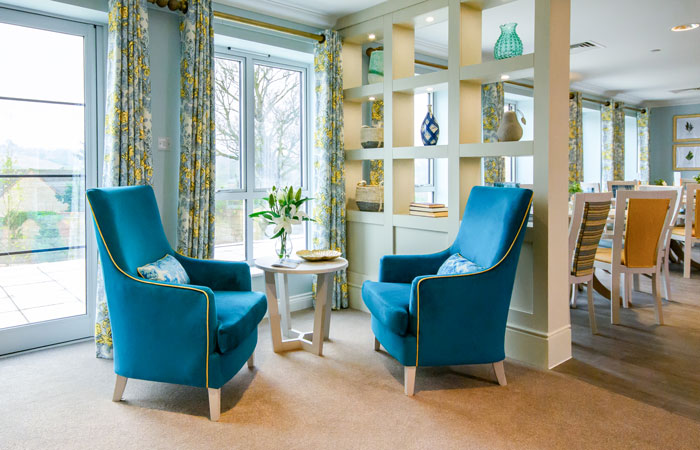
Order of St John Care Trust (OSJCT), Wellford Gardens, Lounge Dining




